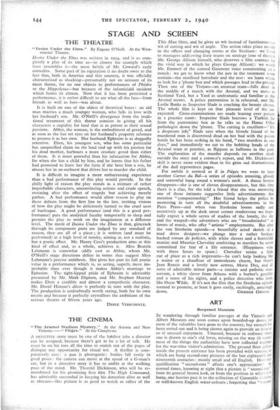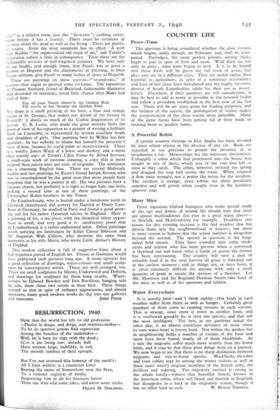ART
Reopened Museum
IN wandering through familiar passages al the Victoria and Albert Museum one soon comes upon boarded-up doors, for most of the valuables have gone to the country, but enough has been sorted out and is being shown again to provide an hour or so of unusual enjoyment. Unusual, because in ordinary times one is drawn to one's old loves, missing on the way (it seems) most of the things the authorities have now collected together for the war-time visitor's admiration. The ground floor gallery inside the present entrance has been provided with screens, al which are hung second-rate pictures of the late eighteenth and nineteenth centuries : mostly small and all English. How that qualification " second-rate " affects one's appreciation! lit normal times, knowing at sight that a picture is " second-rate from its general brown look, or from the position in which it is hung, one hurries past it to the collection of Constable s!:ctches or well-known English water-colours ; forgetting that " second- rate" is a relative term, just like "first-rate "; curbing enjoy- ment before it has a chance. There must be revisions of opinion about the dead as well as the living. There are plenty, of course. Even the stray comment has its effect. A poet calls Ruskin "the organ-voiced old maid of art," and Turner's reputation suffers a little in consequence. Then there are the fashionable revivals of half-forgotten painters. We have only to say loudly, and enough times, that Fuseli was as great a painter as Hogarth and the dictionaries of painting, in their future editions, give Fuseli as many inches of space as Hogarth.
There are paintings on these screens—" second-rate," of course—that ought to prompt some revisions. The reputation of Thomas Stothard, friend of Beckford, fashionable illustrator and decorator of mansions, stood little chance after Blake had said of him : You all your Youth observ'd the Golden Rule Till you're at last become the ,Golden Fool.
Yet there is a small painting of his here, a blue and orange vision of St. George, that makes one dream of the beauty of Foothill: it distils so much of the Gothic imagination of its period. C. R. Leslie, who made the great mistake from the point of view of his reputation as a painter of writing a brilliant book on Constable, is represented by several excellent heads and shoulders of girls. One painting here by Wilkie has fine qualities: he has nobody to blame but himself for posterity's view of him, because he could paint so meretriciously. There is a worthy James Ward of a horse and donkey, and a more than worthy coin of Titian's Uffizi Venus by Alfred Stevens, a small-scale work of extreme cunning, a copy that is more original than ninety-nine per cent, of originals. The sentiment has a charming English bias. There are several Mulready studies and two paintings by Keats's friend Joseph Severn, who was so overshadowed by the great man that most people have -forgotten that he was a painter at all. His two pictures have a tenuous charm, but probably it is right to forget him, one feels, looking a second time at one of these paintings, of the Christopher Robin brothers in the Tower.
De Loutherbourg, who is buried under a handsome tomb in Chiswick churchyard, did scenery for Garrick at Drury Lane. Born in Germany, he studied in Paris and found a good grow- ing soil for his rather theatrical talents in England. Here is a painting of his, a sea piece, with the theatrical talent upper- most as usual, and very good it is : satisfactory proof that de Loutherbourg is a rather underrated artist. Other paintings worth noticing are landscapes by Julius Caesar Ibbetson and Sir Augustus Wall Calcott, who deserves the same faint memories as his wife Maria, who wrote Little Arthur's History of England.
This modest collection is full of suggestive hints about a half-forgotten period of English art. France or Germany would have publicised such pictures long ago. A room upstairs has a good collection of drawings, water-colours and small sculp- tures by contemporary artists. These are well arranged, too. There are small sculptures by Moore, Underwood and Dobson, and drawings for sculpture by them hang nearby. Water- colours by Edward Bawden and Eric Ravilious, hanging side by side, show these two artists at their best. These things remind us that in spite of ordinary appearances, and almost unawares, many good modern works do slip into our galleries







































 Previous page
Previous page